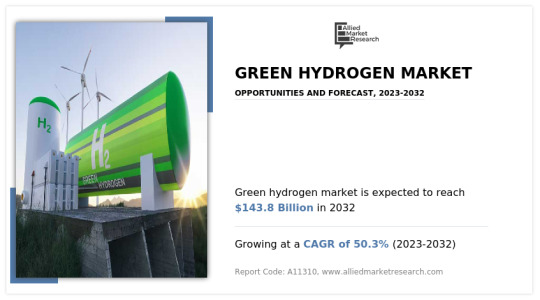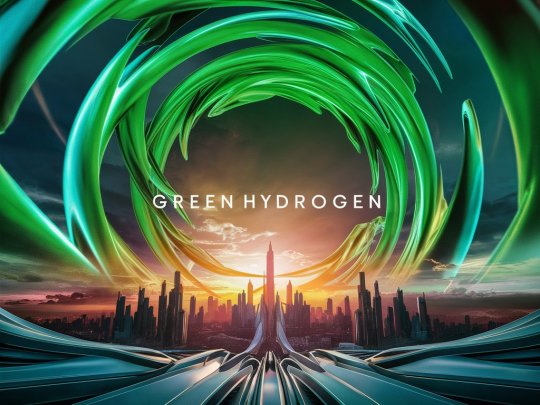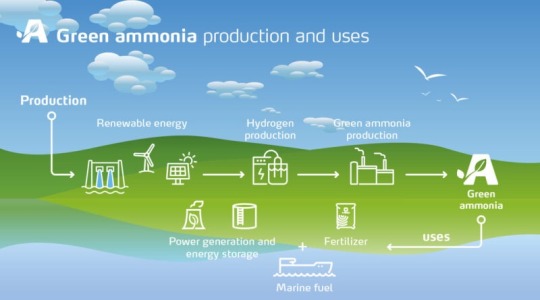#green hydrogen
Text
#good news#science#environmentalism#climate change#co2#carbon emissions#hydrogen#green hydrogen#fossil fuel alternatives#green energy#airplanes#aviation#sustainable aviation#environment
179 notes
·
View notes
Text
TES Canada is investing $4 billion, without public funding, to build a Shawinigan, Que. plant producing "green" hydrogen, a fuel used to reduce dependence on hydrocarbons in industry and heavy transport.
"This is the first green hydrogen project in the country," said federal Innovation Minister François-Philippe Champagne at a press conference in Shawinigan on Friday morning, accompanied by Quebec's Economy and Energy Minister Pierre Fitzgibbon.
The plant's main customer will be Énergir, which will use the hydrogen to produce around one-fifth of its 115 million cubic meters of renewable natural gas (RNG) by 2030.
Continue Reading.
Tagging @politicsofcanada
39 notes
·
View notes
Text
8 notes
·
View notes
Text
Green hydrogen successfully produced from plastic waste
Scanning electron microscope (SEM) image of layered stacks of nano-scale flash graphene sheets formed from waste plasticKevin Wyss/Tour lab
Low-emissions strategy that could pay for itself helps scientists achieve high-yield hydrogen gas and high-value graphene.
Climate change has made scientists seek renewable energy where it can be found. While manufacturing products out of waste is on the…

View On WordPress
7 notes
·
View notes
Text
The Role of Renewable Energy Sources in Powering the Green Hydrogen Market
According to a new report published by Allied Market Research, the green hydrogen market was valued at $2.5 billion in 2022, and is estimated to reach $143.8 billion by 2032, growing at a CAGR of 50.3% from 2023 to 2032.

Green hydrogen, also known as renewable hydrogen, is a form of hydrogen produced using renewable energy sources, such as solar, wind, or geothermal power. Furthermore, the demand for proton exchange membrane electrolyzer is anticipated to witness growth during the forecast period, owing to economic growth in emerging markets continues to surge.
Request Sample Pages: https://www.alliedmarketresearch.com/request-sample/11675
In 2023, Asia-Pacific accounts for the largest green hydrogen market share, followed by Europe and North America.
Major Companies
Green Hydrogen Systems, Air Liquide, Shell plc, Enapter S.r.l., Plug Power Inc., Ballard Power Systems, Linde plc, Reliance Industries, GAIL (India) Limited and Adani Green Energy Ltd.
The green hydrogen market is expected to be driven by factors such as the promising growth of the food and beverages, medical, chemical, and petrochemical industries.
Demand for power generation has escalated due to global population growth, coupled with urbanization and industrialization, leading to increase electricity consumption.
The food and beverage segment are projected to manifest a CAGR of 51.6% from 2023 to 2032, and has significant proportion in green hydrogen market size. Rise in the food and beverage industry significantly influences the green hydrogen market, primarily due to intensive energy demand of the industry.
Food and beverage production requires substantial energy for processing, packaging, refrigeration, and transportation. Green hydrogen presents a sustainable solution to meet these escalating energy demands, especially in processes were direct electrification not efficient.

Rise in living standards and technological advancements also contribute to higher energy needs, especially in emerging economies where electricity access has expanded rapidly.
Ongoing R&D efforts focus on enhancing electrolyzer efficiency, durability, and scaling up production, leading to cost reductions and improved performance. This trend aligns with ambitious governmental targets and corporate commitments aimed at fostering the green hydrogen industry, spurring innovation and market growth.
Increasingly stringent regulations and carbon pricing mechanisms incentivize to transition of industries into low-carbon alternatives, propelling its market penetration. These converging green hydrogen market trends collectively position green hydrogen as a pivotal player in the sustainable energy landscape, driving a fundamental shift toward cleaner, more resilient energy systems across the globe.
Enquiry Before Buying: https://www.alliedmarketresearch.com/purchase-enquiry/11675
the electrification of transportation and heating sectors, driven by the push for cleaner energy sources, further amplifies the demand for power generation. This growth in demand provides a significant opportunity for the green hydrogen market.
Green hydrogen emerges as a versatile solution as traditional energy sources struggle to meet these escalating demands while maintaining environmental sustainability.
This symbiotic relationship between the rise in demand for power generation and the need for clean energy solutions positions green hydrogen as a key player in meeting the escalating energy needs sustainably.
The push toward decarbonization and the reduction of greenhouse gas emissions in the transportation sector amplifies the appeal of green hydrogen market opportunities.
Carbon Solutions, a greenhouse gas reduction consultancy, in May 2023, stated that less than 1% of the 10 million metric tons of hydrogen produced in the U.S. at present counts as green hydrogen. Instead, 76% is derived from natural gas or coal, and 23% is a by-product of petroleum refining or other chemical processes.
Globally, the hydrogen market is about 96 million metric tons per year. The report from Carbon Solutions puts number of electrolyzers operating in the U.S. at just 42, with a combined hydrogen production capacity of about 3,000 tons per year.
Get a Customized Research Report: https://www.alliedmarketresearch.com/request-for-customization/11675
The U.S. Department of Energy (DOE) aims to have 10 million tons of clean hydrogen flowing per year by 2030, 20 million tons by 2040, and 50 million tons by 2050. About half that production is expected to come from renewably powered electrolysis. The U.S. government is projected to invest $8 billion in several hydrogen hubs across the country by 2026 and produce about 250 times as much hydrogen per day.
About Us
Allied Market Research (AMR) is a full-service market research and business-consulting wing of Allied Analytics LLP based in Portland, Oregon. Allied Market Research provides global enterprises as well as medium and small businesses with unmatched quality of "Market Research Reports" and "Business Intelligence Solutions." AMR has a targeted view to provide business insights and consulting to assist its clients to make strategic business decisions and achieve sustainable growth in their respective market domain.
Pawan Kumar, the CEO of Allied Market Research, is leading the organization toward providing high-quality data and insights. We are in professional corporate relations with various companies and this helps us in digging out market data that helps us generate accurate research data tables and confirms utmost accuracy in our market forecasting. Each and every data presented in the reports published by us is extracted through primary interviews with top officials from leading companies of domain concerned. Our secondary data procurement methodology includes deep online and offline research and discussion with knowledgeable professionals and analysts in the industry.
2 notes
·
View notes
Text
News from Africa, 19 June
Hage Geingob will host Danish PM Mette Frederiksen and Dutch PM Mark Rutte today in Namibia. Green hydrogen will reportedly be among the subjects discussed.

2. Namibia's proposed visa exemption for Chinese nationals is a bilateral agreement that would benefit both countries, according to China's ambassador to Namibia, Zhao Weiping.
Some Namibian politicians have objected to the proposal, with opposition leader McHenry Venaani claiming it is a "hoodwinking process" for Chinese prisoners to come to the country, and aspiring presidential candidate Job Amupanda alleging that it involves a deal between the ruling party and China to garner support for next year's elections.
The proposed agreement's main goal is to attract Chinese tourists and help Namibia become competitive again after the Covid-19 pandemic, according to Namibia's minister of home affairs, immigration, safety and security, Albert Kawana.
3. Angola and Zambia signed a memorandum of understanding to enhance cooperation in information technology, including digital transformation, AI, and space technology.
The agreement includes the establishment of direct cross-border optical fibre backbone connectivity between the two countries, scheduled to happen this month.
The collaboration is expected to help improve the regulation of the Angolan and Zambian telecom markets and lead to improved coverage and quality of ICT services provided in both countries.
4. Namibia is embarking on a journey of digital transformation to modernize various aspects of the country's life.
The Department of Home Affairs, Immigration and Security recently announced the successful implementation of an online passport application system, a major step towards delivering home affairs government services through digital channels. Namibia is partnering with Estonia to bring government services online and gradually prepare citizens for the transformation ahead. The Vice Minister of ICT recognizes the importance of foreign direct investment (FDI) for African technology spaces, but stresses the need for a clear roadmap or strategy to ensure that solutions developed in Africa fit the lifestyle on the continent.
5. Nigeria has 71 million people living in extreme poverty and 133 million people are classified as multidimensionally poor, according to 2023 data from the World Poverty Clock and the National Bureau of Statistics.
6. The Bank of Namibia increased the repo rate to safeguard the dollar-rand peg and contain inflationary pressures, but this will severely impact consumers who rely on debt to survive.
The governor expressed empathy for people losing their homes due to rising debt costs, and urged the nation to find better solutions to keep more Namibians in their homes while maintaining financial stability.
7. The fighting in Sudan has caused a surge in refugees fleeing to South Sudan, exacerbating an already dire humanitarian crisis.
The UN has called for $253 million in funding to respond to the crisis, but donations have been slow to come in.
The lack of resources and funding has led to inadequate food, water, and sanitation facilities in transit camps, resulting in malnutrition, disease, and preventable deaths.
#Dutch PM#Danish PM#visit#Namibia#Green Hydrogen#China#visas#tourists#Angola#Zambia#ICT#network#digital#Nigeria#poverty#clock#currency peg#South Africa#refugees#crisis#food#sanitation#Sudan#Africa
3 notes
·
View notes
Text
GERMANY’S FAR RIGHT IS SURGING
Peter Fitzek is the self-proclaimed “King of Germany.” (https://www.haaretz.com/world-news/europe/2018-08-09/ty-article-magazine/.premium/guns-anti-semitisms-and-fake-kings-germanys-dangerous-new-cult/0000017f-f7e9-ddde-abff-ffedb1fd0000)
A Skynews report earlier this week profiled a town in Germany where thousands of “extremists” were gathering to give their allegiance to the new king of…

View On WordPress
#Bill Gates#BRICS#Burisma#CEFC#CELAC#Chris van Tulleken#Communit of Latin Americanand aribbean States#First Steps Nutrition Trust#green hydrogen#Hamtramck#Hunter Bden#Jenny Hill#Johannesburg#Kaiser#King of Germany#Konigreich Deutchland#LGBTQ#Marshall Plan#Narendra Modi#OceanGate#Peter Fitzak#Peter the First#Reichsburger#Reichstag#Rushi Sunak#Suzanne Lynch#Titanic#Ukraine#Ukraine Recovery Conference#UNESCO
3 notes
·
View notes
Text
Different colours for hydrogen gas
Using the right type of hydrogen gas can help achieve net zero.
Energy gotten from hydrogen gas is the only available energy that produces water, electricity, and heat when consumed in a fuel cell.

View On WordPress
4 notes
·
View notes
Link
Excerpt from this story from DeSmog Blog:
The push to sell “blue hydrogen” as a clean energy fuel — which experts have called a misleading rebrand of fossil fuels — hit another setback this month.
Climate provisions in the Inflation Reduction Act of 2022 are bringing new economic headwinds to the gas-derived hydrogen fuel’s prospects. However, many companies invested in the continued existence of the natural gas industry are not giving up on the effort, presumably because blue hydrogen promises to extend the life of natural gas producers.
DeSmog has mapped for the first time the major U.S. players in the blue hydrogen sphere — and natural gas is a common denominator.
Blue hydrogen is the industry name for hydrogen, an energy carrier, that is created from natural gas but would theoretically employ carbon capture technology to prevent the resulting carbon dioxide emissions from entering the atmosphere. However, as DeSmog has previously reported, carbon capture has failed to work in blue hydrogen production facilities at rates that would qualify the hydrogen as “clean.”
Blue hydrogen’s supporters have argued that the world needs the gas-dependent fuel until it could scale up affordable clean hydrogen (known as “green hydrogen,” which uses renewable energy and does not produce any carbon dioxide or methane emissions).
It was a compelling financial argument, and in January 2021, when DeSmog first reported on efforts to establish a hydrogen economy in the United States, energy analysts were estimating that green hydrogen might take until 2040 to become economically competitive with gas-derived hydrogen.
That same month, Shell wrote on its website: “Whilst green hydrogen is the ideal aspiration for a low-carbon energy future, that technology has a number of years to go before it is of a competitive price range.”
Since then, those expectations have been completely upended by a combination of factors, including the rapidly falling cost of renewable electricity — which makes green hydrogen cheaper — and the sizable increase in the price of natural gas — which makes blue hydrogen costlier.
When the push for blue hydrogen began in 2020, the price of natural gas in the United States averaged $2.05 per million British thermal units (MMBtu). Now, it’s more than $9/MMBtu — a quadrupling in price. It’s clear now that not only is blue hydrogen not truly clean, but the economics don’t work. Even Shell has changed its tune: Earlier this month, the renewable energy publication Recharge reported that the oil company’s CEO said soaring gas prices mean blue hydrogen will not be able to compete economically with green hydrogen “for some while.”
9 notes
·
View notes
Text
Abu Dhabi Sustainability Week 2023, Agenda for Global Climate Action

Abu Dhabi Sustainability Week (ADSW) 2023, features discussions on climate action leading up to COP28, including the opening ceremony held on Saturday and followed by Zayed Sustainability Awards ceremony, and the first Green Hydrogen Summit.
Read More
#united arab emirates#uae#abudhabi gp#sustainability#sustainable#ecology#climate and environment#climate change#climate action#cop28#sheikh mohammed bin zayed al nahyan#zayed#awards#award ceremony#ceremony#green hydrogen#summit#dubai#abudhabi#emirates#gulf#gulf countries#middleeast#arabian#arab news#economy#economics#global#economic situation#economic conditions
4 notes
·
View notes
Text
Unraveling the Green Hydrogen Conundrum: A Deep Dive into TotalEnergies CEO Patrick Pouyanné's Perspective
In the global discourse on sustainable energy, the concept of green hydrogen has emerged as both a beacon of hope and a source of skepticism. At the forefront of this debate stands Patrick Pouyanné, the visionary CEO of TotalEnergies, whose nuanced understanding of the complexities surrounding green hydrogen offers invaluable insights into its potential and pitfalls.
As Pouyanné addressed a distinguished audience at the World Economic Forum in Riyadh, his message resonated with a sense of pragmatism that is often overshadowed by the fervor surrounding green technologies. He pointed to the stark realities of today's energy landscape, where the promise of green hydrogen is tempered by logistical challenges and economic constraints.
Central to Pouyanné's discourse is the issue of demand, a fundamental driver of any sustainable energy transition. While green hydrogen holds immense promise as a clean and versatile fuel, its widespread adoption hinges on the creation of robust market mechanisms that incentivize investment and innovation. Without a clear pathway to scalability, green hydrogen risks languishing in the realm of niche applications, failing to realize its transformative potential.
Moreover, Pouyanné draws attention to the critical role of infrastructure in enabling the transition to green hydrogen. Electrolysers, the cornerstone of green hydrogen production, remain woefully underdeployed due to a combination of technical barriers and economic uncertainties. Addressing these challenges requires concerted efforts from both public and private stakeholders to accelerate the development and deployment of essential infrastructure.
Amidst lofty aspirations and ambitious targets set by policymakers, Pouyanné offers a sobering reminder of the need for realism and pragmatism. While the European Union aims to produce 20 million tonnes of low-carbon hydrogen annually by 2030, recent studies suggest a more tempered outlook on industrial demand, underscoring the importance of aligning expectations with market realities.
In advocating for a diversified approach to decarbonization, Pouyanné emphasizes the pivotal role of biofuels derived from biomass. Unlike green hydrogen, which faces significant hurdles in terms of cost and scalability, biofuels offer a more immediate and commercially viable solution for reducing greenhouse gas emissions across multiple sectors.
Furthermore, Pouyanné's stance on sustainable aviation fuel (SAF) reflects a holistic understanding of the interplay between technology, economics, and environmental impact. Rather than hastily embracing green hydrogen as a panacea for aviation decarbonization, he advocates for a balanced approach that leverages existing biomass-based technologies to produce SAF in a cost-effective and sustainable manner.
As we reflect on Pouyanné's insights, it becomes evident that the path to a greener future is fraught with complexities and trade-offs. The journey towards widespread adoption of green hydrogen requires a nuanced understanding of market dynamics, technological feasibility, and policy imperatives.
In closing, Pouyanné's vision challenges us to rethink our approach to sustainable energy and embrace a spirit of collaboration and pragmatism. By harnessing the collective expertise and ingenuity of industry stakeholders, we can overcome the obstacles hindering the transition to green hydrogen and pave the way for a more sustainable and prosperous future.
If you want to learn more about Green Hydrogen, check out Green Hydrogen Revolution: A Path to Sustainable Energy. Discover the untapped potential of green hydrogen in reshaping our energy landscape. This insightful book unveils its role in combating climate change and offers a cleaner, renewable energy solution. Join us in the journey to a sustainable, decarbonized world. A must-read for those passionate about a greener future!"
What are your reflections on Pouyanné's perspective? How do you envision the role of green hydrogen in shaping the future of energy? Join the dialogue and share your insights as we chart a course towards a cleaner, more resilient energy ecosystem.
0 notes
Text
Discovered Enzyme Turns Air into Electricity, a New Clean Way to Make Energy Dreams Come True https://www.goodnewsnetwork.org/discovered-enzyme-turns-air-into-electricity-to-make-energy-dreams-true/
#good news#nature#science#environmentalism#environment#bacteria#microbiology#australia#hydrogen#green hydrogen#green energy
20 notes
·
View notes
Text
Green Hydrogen-Why Experts think Green Hydrogen is important?
Top discussion on Green Hydrogen. #GreenHydrogen #Sustainability
Green Hydrogen is the present as well as the future. Top Discussion on Green Hydrogen.

View On WordPress
0 notes
Text
ES Ranganathan Delving into India's Green Hydrogen
To boost India's goal of using clean energy, the Government launched the National Green Hydrogen Mission in 2022. According to ES Ranganathan, an expert in the Oil and Energy industry and former marketing director of GAIL, this initiative aims to create a full-fledged system for producing, storing, and using green hydrogen in India. It aims to make green hydrogen widely used in various sectors like transportation, industry, and power generation.
The mission has several key goals. Firstly, it wants to set up a national hydrogen energy mission to effectively use hydrogen as an energy source. Secondly, it focuses on supporting research and development (R&D) to improve hydrogen production, storage, and use technologies. This R&D push aims to make hydrogen systems more efficient. Thirdly, it aims to promote local manufacturing of hydrogen-related equipment and infrastructure. This will help India become self-sufficient in the hydrogen industry and reduce reliance on imports.
Read More
0 notes
Text
Green Hydrogen with Green Ammonia Twist + $4 BILLION USD in Investment Support Solidifies Path to Large and Small GH Commercialization
Image: Green ammonia production from green hydrogen courtesy of World Economic Forum.
The debate over green hydrogen continues, but the flow, the deluge of BILLIONS of DOLLARS into new and larger GH projects, solidifies the path to Commercialization for both large and small applications.
In the latest news, the Saudi-listed desalination powerhouse ACWA Power has just added another notch in its…

View On WordPress
#Amonia#Colorado School of Mines#Genesis Nanotechnology#Green Hydrogen#Nanomaterials#Nanotechnology#NREL#Toyota
3 notes
·
View notes
Text
0 notes